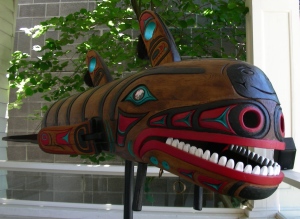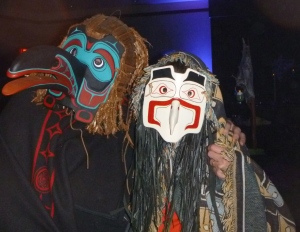 A Grove of Totems My home is in a grove of totems. Five large poles and many small ones surround me with stories that speak of trickster and bear. Joining eagle, raven and most recently thunderbird I imagine soaring high above our chimney to survey life’s possibilities. At times I watch beaver chopping trees to provide firewood for winter warmth.
A Grove of Totems My home is in a grove of totems. Five large poles and many small ones surround me with stories that speak of trickster and bear. Joining eagle, raven and most recently thunderbird I imagine soaring high above our chimney to survey life’s possibilities. At times I watch beaver chopping trees to provide firewood for winter warmth.
In theatrical performances I have been known as fishhawk, and am called to use my keen eyes to spot whales far out at sea. Shouting “caw . . caw” I tell the people waiting patiently on land the location of these graceful behemoths. Great excitement is always displayed when my voice rings true, and those on the beach mimic me with raised shouts mingled with drumming and preparation. When I appear, a magnificent wooden whale glides forth to greet me. His large toothy mouth opens and closes in deep drumming rumble while his tail flaps silently as he moves.
 My partner of nineteen years, Ray Losey, is the master carver whose chopping and hammering sounds emanate rhythmically from under the house. Ray grew up surrounded by the art, and as a child helped his father carve and paint the huge poles that now reside in parks and private residences. His dad had been given the right to carve by Chief Joseph in Kake Alaska ,and he in turn passed the gift on to his son. With mixed native blood lines on both sides of his family, Ray’s DNA tells of ancestors who came from Oceana over 10,000 years ago.
My partner of nineteen years, Ray Losey, is the master carver whose chopping and hammering sounds emanate rhythmically from under the house. Ray grew up surrounded by the art, and as a child helped his father carve and paint the huge poles that now reside in parks and private residences. His dad had been given the right to carve by Chief Joseph in Kake Alaska ,and he in turn passed the gift on to his son. With mixed native blood lines on both sides of his family, Ray’s DNA tells of ancestors who came from Oceana over 10,000 years ago.
The cedar poles and smaller masks are carved in his studio that overlooks the green lush canopy of our surrounding woods. The smell of the oily wood with its deep brown luster when polished give me a feeling of warmth and contentment. I particularly like looking at the long narrow sisiutls gracing our walls. Originally serving as decorative lintels placed over entrance doorways, sisiutl designs are thought to hark back to 1421 when the Chinese visited America leaving dragon-aced coins behind. Often carved with two outward facing creatures protecting a central humanoid face, the planks are primarily used as fanciful wall art today.

Northwest coastal natives lived comfortable lives. Rivers were stocked with fish, land was abundant with deer and beaver, berries and plants were plentiful, and though wet, the weather was not excessively cold. During long winter months there was time to carve, tell stories, and hold potlatches that drew family and friends together in celebration. The custom of the entire family making blankets, baskets, cooking utensils, and carvings to be given away during these festivities tied the community together. If your clan gave everything away during a potlatch then the recipients were obligated to your future well being, and you were considered wealthy. Just as in our own holiday celebrations food, music an dance add to the liveliness of the gathering.
Totem  poles at our home are displayed as non-tribal specific pieces dedicated to myths and legends of a time past. Made of rot-resistant cedar and carved to represent characters in stories, they primarily serve as a functional pieces to welcome visitors to our home. In the old days the carving was limited because of stone tools but once contact was made with white man and metal tools were introduced an thriving trade developed. Some early settlers mistakenly thought that there was religious meaning to the carvings and unfortunately these ignorant missionaries burned hundreds of artifacts in false assumption that they were being worshiped. They primarily had been constructed as a way of identifying lineage. The pole to the left is of watchman protecting the home.
poles at our home are displayed as non-tribal specific pieces dedicated to myths and legends of a time past. Made of rot-resistant cedar and carved to represent characters in stories, they primarily serve as a functional pieces to welcome visitors to our home. In the old days the carving was limited because of stone tools but once contact was made with white man and metal tools were introduced an thriving trade developed. Some early settlers mistakenly thought that there was religious meaning to the carvings and unfortunately these ignorant missionaries burned hundreds of artifacts in false assumption that they were being worshiped. They primarily had been constructed as a way of identifying lineage. The pole to the left is of watchman protecting the home.
Some of Ray’s works are memorial pieces that tell stories, as is the case of the Survival Pole recently erected at the Oregon Zoo. It speaks loudly of the ways contemporary man is destroying animal habitat. Owl looks out with a missing an eye, and eagle hesitantly holds up a bent wing. Poor beaver has a broken tooth and bear, quite sadly is missing the lower part of fingers that were caught in a trap. Other poles are carved to celebrate life by becoming a repository for a loved relative’s ashes. Serving as mortuary vessels, a few have cavities large enough for an entire family to mingle in death.
I liken Christmas festivities to those potlatches held by native people. We too give gifts, proclaiming our love and connectedness to family and friends. There is even a sense of obligation that binds us as we weave a web of giving. The pleasure that comes from reaching out is an ancient one that can bind us together and make us feel whole.
With this in mind Ray and I wish you a most wonderful holiday with your family and friends.

To see more of Ray’s work go to www.raylosey.com.
Home » Blog » A Grove of Totem Poles
Table of Contents
In theatrical performances I have been known as fishhawk, and am called to use my keen eyes to spot whales far out at sea. Shouting “caw . . caw” I tell the people waiting patiently on land the location of these graceful behemoths. Great excitement is always displayed when my voice rings true, and those on the beach mimic me with raised shouts mingled with drumming and preparation. When I appear, a magnificent wooden whale glides forth to greet me. His large toothy mouth opens and closes in deep drumming rumble while his tail flaps silently as he moves.
The cedar poles and smaller masks are carved in his studio that overlooks the green lush canopy of our surrounding woods. The smell of the oily wood with its deep brown luster when polished give me a feeling of warmth and contentment. I particularly like looking at the long narrow sisiutls gracing our walls. Originally serving as decorative lintels placed over entrance doorways, sisiutl designs are thought to hark back to 1421 when the Chinese visited America leaving dragon-aced coins behind. Often carved with two outward facing creatures protecting a central humanoid face, the planks are primarily used as fanciful wall art today.
Northwest coastal natives lived comfortable lives. Rivers were stocked with fish, land was abundant with deer and beaver, berries and plants were plentiful, and though wet, the weather was not excessively cold. During long winter months there was time to carve, tell stories, and hold potlatches that drew family and friends together in celebration. The custom of the entire family making blankets, baskets, cooking utensils, and carvings to be given away during these festivities tied the community together. If your clan gave everything away during a potlatch then the recipients were obligated to your future well being, and you were considered wealthy. Just as in our own holiday celebrations food, music an dance add to the liveliness of the gathering.
Totem poles at our home are displayed as non-tribal specific pieces dedicated to myths and legends of a time past. Made of rot-resistant cedar and carved to represent characters in stories, they primarily serve as a functional pieces to welcome visitors to our home. In the old days the carving was limited because of stone tools but once contact was made with white man and metal tools were introduced an thriving trade developed. Some early settlers mistakenly thought that there was religious meaning to the carvings and unfortunately these ignorant missionaries burned hundreds of artifacts in false assumption that they were being worshiped. They primarily had been constructed as a way of identifying lineage. The pole to the left is of watchman protecting the home.
poles at our home are displayed as non-tribal specific pieces dedicated to myths and legends of a time past. Made of rot-resistant cedar and carved to represent characters in stories, they primarily serve as a functional pieces to welcome visitors to our home. In the old days the carving was limited because of stone tools but once contact was made with white man and metal tools were introduced an thriving trade developed. Some early settlers mistakenly thought that there was religious meaning to the carvings and unfortunately these ignorant missionaries burned hundreds of artifacts in false assumption that they were being worshiped. They primarily had been constructed as a way of identifying lineage. The pole to the left is of watchman protecting the home.
Some of Ray’s works are memorial pieces that tell stories, as is the case of the Survival Pole recently erected at the Oregon Zoo. It speaks loudly of the ways contemporary man is destroying animal habitat. Owl looks out with a missing an eye, and eagle hesitantly holds up a bent wing. Poor beaver has a broken tooth and bear, quite sadly is missing the lower part of fingers that were caught in a trap. Other poles are carved to celebrate life by becoming a repository for a loved relative’s ashes. Serving as mortuary vessels, a few have cavities large enough for an entire family to mingle in death.
I liken Christmas festivities to those potlatches held by native people. We too give gifts, proclaiming our love and connectedness to family and friends. There is even a sense of obligation that binds us as we weave a web of giving. The pleasure that comes from reaching out is an ancient one that can bind us together and make us feel whole.
With this in mind Ray and I wish you a most wonderful holiday with your family and friends.
To see more of Ray’s work go to www.raylosey.com.
Table of Contents